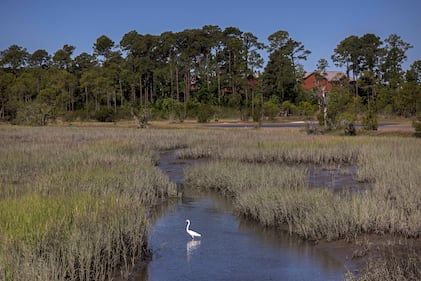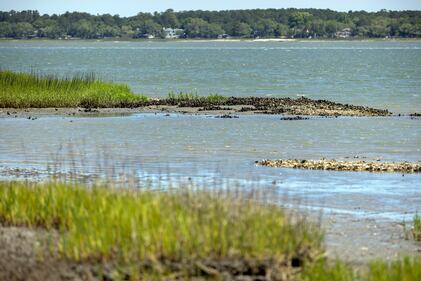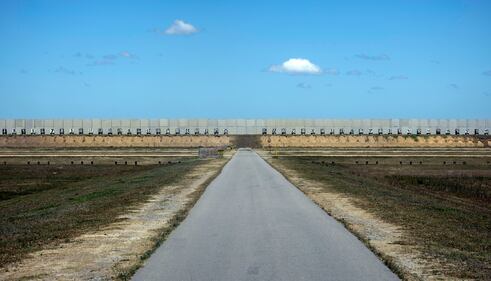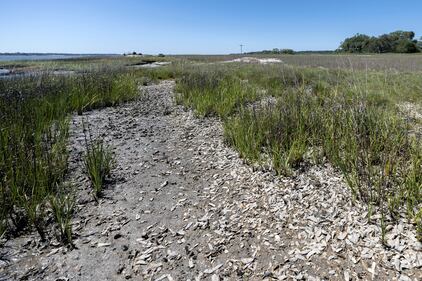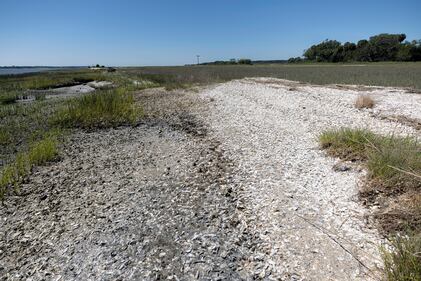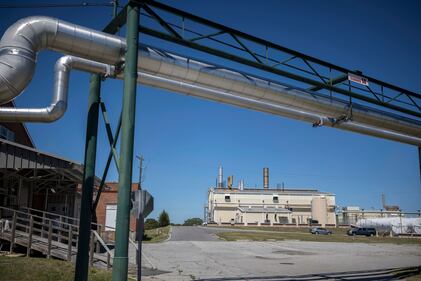PARRIS ISLAND, S.C. — Rising seas are encroaching on one of America’s most storied military installations, where thousands of recruits are molded into Marines each year amid the salt marshes of South Carolina’s Lowcountry region.
Marine Corps Recruit Depot Parris Island is particularly vulnerable to flooding, coastal erosion and other impacts of climate change, a Defense Department-funded “resiliency review” noted last month. Some scientists project that by 2099, three-quarters of the island could be under water during high tides each day.
Military authorities say they’re confident they can keep the second-oldest Marine Corps base intact, for now, through small-scale changes to existing infrastructure projects.
Image 0 of 7
Maj. Marc Blair, Parris Island’s environmental director, describes this strategy as “the art of the small,” a phrase he attributes to the base’s commanding general, Brig. Gen. Julie Nethercot. In practice, it means such things as raising a culvert that needs to be repaired anyway, limiting development in low-lying areas and adding floodproofing measures to firing range upgrades.
Others advocate much larger and more expensive solutions, such as building huge seawalls around the base, or moving Marine Corps training away from the coast altogether.
Parris Island has an outsized role in military lore and American pop culture as a proving ground for Marines who have served in every major conflict since World War I. It remains a crucial training ground, along with Marine Corps Recruit Depot, San Diego. But the rising sea is proving to be a formidable enemy.
Salt marsh makes up more than half of the base’s 8,000 acres (3,200 hectares), and the depot’s highest point, by the fire station, is just 13 feet (4 meters) above sea level. It is linked to the mainland by a single road that’s already susceptible to flooding.
Low-lying areas on the island and the nearby Marine Corps air station already flood about ten times a year, and by 2050, “the currently flood-prone areas within both bases could experience tidal flooding more than 300 times annually and be underwater nearly 30 percent of the year given the highest scenario,” according to the Union of Concerned Scientists.
Military reports have for decades acknowledged threats from climate change to national security, as wildfires, hurricanes and floods have prompted evacuations and damaged bases. A Pentagon document published last fall, after President Joe Biden ordered federal agencies to revamp their climate resilience plans, says the Department of Defense now has “a comprehensive approach to building climate-ready installations” and cites an adaptation and resilience study undertaken by Parris Island.
RELATED
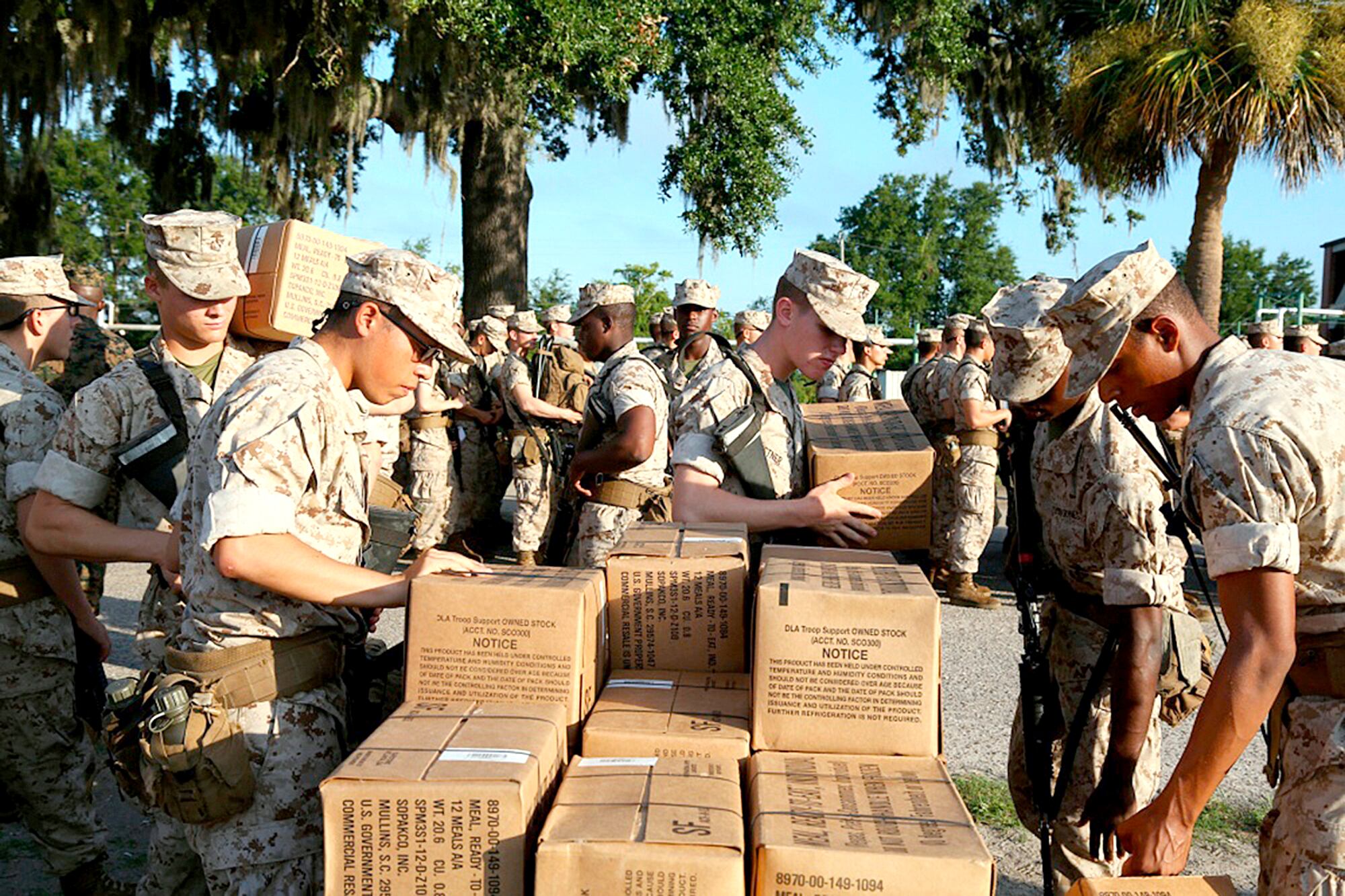
But day-to-day disruptions are growing, from nuisance flooding on roads to rising temperatures and higher humidity that when combined, limit the human body’s ability to cool down with sweat.
Those wetter, hotter days could limit outdoor training. Already, more than 500 people on Parris Island suffered from heat stroke and heat exhaustion between 2016 and 2020, putting the base among the top ten U.S. military installations for heat illnesses, according to the Armed Forces Health Surveillance Branch.
All the training that happens at Parris Island could be technically replicated on cooler, drier land somewhere else, said retired Brig. Gen. Stephen Cheney, who served as commanding general at the base from 1999 to 2001.
But Cheney doesn’t foresee any appetite in Congress for closing the base and relocating its mission to less risky ground, which means the government needs to start investing in structural solutions to protect its crucial components such as the firing ranges near the water, he said in an interview with The Associated Press.
Spending millions to build seawalls would be cheaper than spending billions to rebuild the base after a devastating hurricane, Cheney reasons.
Parris Island has so far been spared the direct hits that have caused billions in damage to other military installations, but it has been evacuated twice in the last five years for hurricanes, which hit South Carolina every eight years, on average.
In 2018, Hurricane Florence pummeled North Carolina’s Camp Lejeune, washing away the beach used by Marines for training, destroying buildings and displacing personnel. A month later, Hurricane Michael tore through Tyndall Air Force Base in Florida, devastating airplane hangars and causing $3 billion in damage.
Those disasters should serve as cautionary tales for Parris Island, argues Cheney. But there is no grand overhaul currently planned — no concrete bulkheads or other seawalls that could dramatically revise the post’s visual character, no master plan to raise buildings all at once.
Hurricane planning is focused on protecting life and preserving the equipment and buildings necessary to limit training disruptions, said Col. William Truax, the depot’s director of installations and logistics.
“We’re not taking on any major projects because we’ve not experienced a major threat to what we have to do here,” Truax said. “To be honest, these old brick buildings aren’t going anywhere.”
Parris Island also depends on the resilience of communities just off the base. Stephanie Rossi, a planner with the Lowcountry Council of Governments, said the group’s Defense Department-funded study of climate change impacts suggests shoring up the only road on and off the island, elevating buildings and bolstering the storm water system of an area where military families live.
The base also works with environmental groups to support living shoreline projects, building up coastal oyster reefs to strengthen natural buffers to floods and hurricanes.
“The waters will recede,” said Blair, the environmental director. “The more resilient we make this place, the quicker we can get back to making Marines.”

